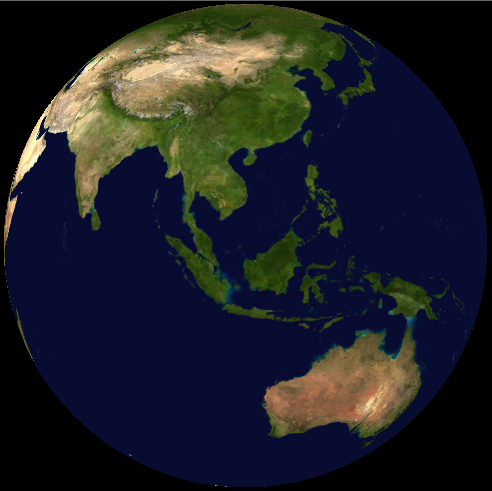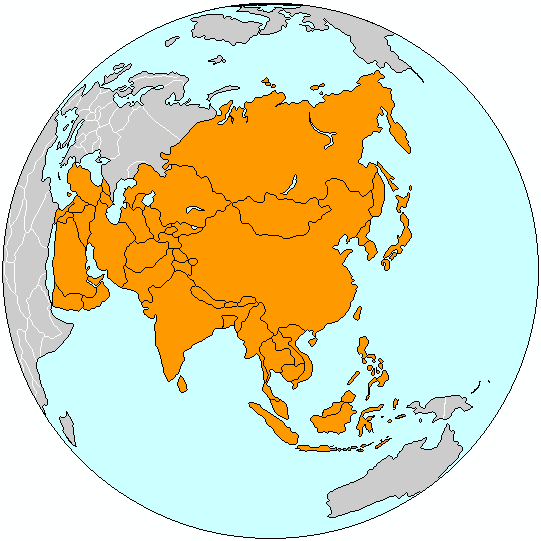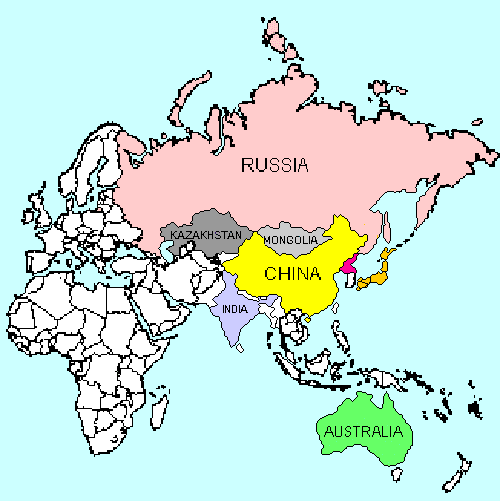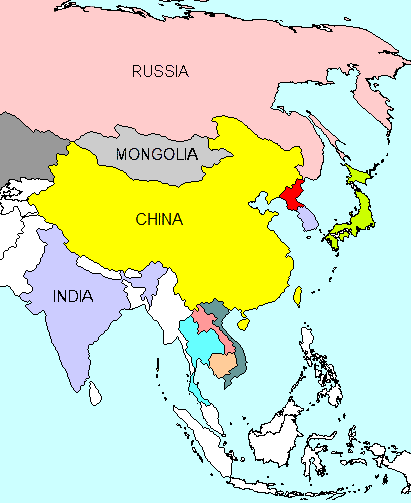Geography Pages
South East Asia after World War II
All boundaries, and borders of countries, are approximate.
Some borders are disputed.
Images in the text are linked to larger images - click on them to see the larger pictures.
Hover the mouse over the images to see their captions.
Brown and blue maps are from the CIA.
![]() Go here for the History of the period.
Go here for the History of the period.
![]()
Before WW II many parts of Asia were under the control of other countries.
India, Burma, Singapore and Hong Kong were British colonies.
Vietnam and Laos were part of French Indo-China.
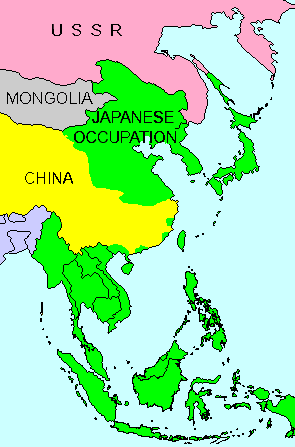 During WW II Japan invaded much of South-East Asia and many of the islands in the Pacific Ocean.
During WW II Japan invaded much of South-East Asia and many of the islands in the Pacific Ocean.
After the surrender of Japan in 1945 the occupied territories were liberated, and many of them did not return to their previous colonial status but achieved autonomy.
According to the CIA World Factbook, Thailand (formerly Siam) is the only South-East Asian country never to have been colonized by a European power.
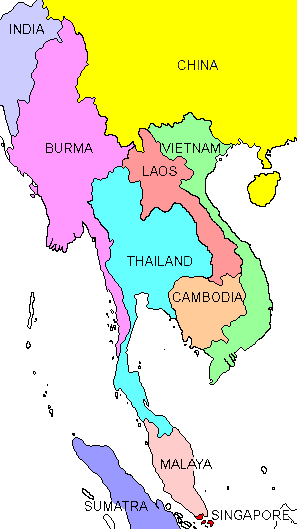 Before WW II the region now occupied by Vietnam, Laos, and Cambodia was known as French Indochina. In 1954 the Geneva Conference put an end to French colonial rule, and divided French Indochina into three countries - Vietnam, the Kingdom of Cambodia, and the Kingdom of Laos
Before WW II the region now occupied by Vietnam, Laos, and Cambodia was known as French Indochina. In 1954 the Geneva Conference put an end to French colonial rule, and divided French Indochina into three countries - Vietnam, the Kingdom of Cambodia, and the Kingdom of Laos
Myanmar was called Burma, and was a British colony along with India.
Bangladesh and Pakistan did not exist - they were part of India, under British rule.
The Malay peninsular was known as Malaya, and was a British colony along with Singapore.
Thailand was called Siam, and was an independent kingdom.
Vietnam - The Socialist Republic of Vietnam
 For more than a thousand years what would become the northern kingdom of Vietnam was part of China, until a Vietnamese warlord defeated a Chinese army and gained independence from the Han dynasty in AD 938. There followed a period of expansion along the coastal lands to the south. During this period Mahayana Buddhism entered the country.
For more than a thousand years what would become the northern kingdom of Vietnam was part of China, until a Vietnamese warlord defeated a Chinese army and gained independence from the Han dynasty in AD 938. There followed a period of expansion along the coastal lands to the south. During this period Mahayana Buddhism entered the country.
During the 16th century there were civil wars between various dynasties in the north and the south.
By 1615 French traders had arrived in the northern regions, and Roman Catholic missionaries came with them.
In 1623 the French Jesuit Alexandre de Rhodes traveled to Macao (the Portuguese trading colony on the coast of China) and then to Hanoi, the capital of the northern kingdom of Vietnam. Alexandre de Rhodes was successful in converting the sister of the king of northern Vietnam, along with hundreds of Vietnamese. The king felt threatened by the growing Christian influence, and drove de Rhodes and his companions out of the country, so de Rhodes and his companions traveled to the southern kingdom, making converts as they went. The Vietnamese Christians remaining in the northern kingdom continued to spread Christianity and to found missions themselves.
In 1787 one of the French priests in northern Vietnam asked the French government to help one of the Vietnamese contenders for the throne, and France became involved in the Vietnamese wars.
During the seventeenth and eighteenth centuries the Christians in Vietnam came under heavy persecution, and thousands of Vietnamese Christians were martyred. In 1834 the French navy was sent to the northern kingdom to intervene in the imprisonment of French missionaries, and the French started to invade and conquer both northern and southern kingdoms.
In 1862 the French took the southern part of the region, naming it Cochinchina. By 1884 the whole of Vietnam was under French control, and in 1887 the land was formally united as French Indochina. The French allowed the Vietnamese ruler to continue, as Emperor of Vietnam, but he was only a puppet figure without much power. The French brought western-style educational systems, and spread Roman Catholicism throughout the territory.
Resistance to the French occupation led to rebellions and the massacres of about a third of the Vietnamese Christians.
During WW II the Japanese invaded and took control of Vietnam in 1940-1945.
After WW II Vietnam was torn by rebellions and the First Indochina War of 1946-1954. After the battle of Ðiên Biên Phù in 1945. President Hô Chí Minh declared Vietnam's independence as the Democratic Republic of Vietnam, but the war continued until 1954.
In 1954 the Geneva Conference put an end to French colonial rule, and divided French Indochina into three countries - Vietnam, the Kingdom of Cambodia, and the Kingdom of Laos. Although the Geneva Conference had intended that Vietnam should be unified, and elections should be held in 1956, that did not happen, and Vietnam was divided into the northern 'Democratic Republic of Vietnam' (under communist rule) and the southern 'Republic of Vietnam'. At that time many of the Roman Catholic Vietnamese moved from the North to the South to escape the communist rule.
The Vietnam War lasted from 1965 to 1975, when North Vietnam declared victory and unified the country under communist rule, naming it the 'Socialist Republic of Vietnam'.
Laos - the Lao People's Democratic Republic
 Laos is the only country in South East Asia to be completely land-locked - it has no sea coast, and hence no ports, so was not an early subject for colonization.
Laos is the only country in South East Asia to be completely land-locked - it has no sea coast, and hence no ports, so was not an early subject for colonization.
Laos was dominated by Siam (Thailand) during the 18th and 19th centuries, but became a French protectorate in 1893, when it became part of French Indo-China. In 1907 France and Siam signed a treaty which defined the current border with Thailand.
During WW II the region was fought over by armies from Vichy France (those who collaborated with the Nazis), Free French, fascist Thai, Chinese Nationalists, and Imperial Japanese.
In 1945 a Laotian nationalist group declared Lao's independence, but the next month the Japanese occupied it again.
At the end of WW II Laos managed to achieve a brief freedom, but in 1946 France reoccupied the country. In 1949 it became autonomous.
In 1953 Laos achieved complete independence, with a constitutional monarchy. However, civil war broke out, and only ended in 1975 when the communist Pathet Lao movement came into power. The communists imprisoned the king, who died in prison, and set up a strict one-party socialist regime, under military control aligned with Vietnam and the Soviet Union.
Cambodia - The Kingdom of Cambodia
 Cambodia was the land of the Khmer Empire, which was founded in 802 AD and which controlled much of South East Asia for 6 centuries. During that time Hinduism, and then Theravada Buddhism, spread from India. Angkor (which may have been the largest pre-industrial city in the world) became the capital city, and the great temple complex of Angkor Wat was built.
Cambodia was the land of the Khmer Empire, which was founded in 802 AD and which controlled much of South East Asia for 6 centuries. During that time Hinduism, and then Theravada Buddhism, spread from India. Angkor (which may have been the largest pre-industrial city in the world) became the capital city, and the great temple complex of Angkor Wat was built.
In 1431 Angkor fell to an invading kingdom, and the city was abandoned in 1432. The Khmer Empire fell into decline, and neighboring countries became more powerful. For the next 300 years Cambodia was usually a vassal state of either Vietnam or Siam, with only brief periods of independence.
In 1511 the Portuguese arrived, and there were further contacts and trade with the Europeans from then on.
Cambodia was caught in the middle of the Siamese-Vietnamese war of 1841-1845, and King Norodon of Cambodia eventually appealed to France for protection.
In 1863 Cambodia came under French protection.
In 1867 the French concluded a treaty with the King of Siam, who renounced his claim to rule over Cambodia, in exchange for two Cambodian provinces which were given to Siam. The provinces were returned to Cambodia in 1907.
In 1887 Cambodia became part of French Indochina. Cambodia remained a French protectorate until the Japanese occupation of 1941-1945.
After WW II France continued in power until 1953, when Cambodia gained independence as a constitutional monarchy. Although King Sihanouk claimed officially to be neutral in the Vietnam war, he did allow Vietnamese communists to use Cambodia as a supply route for their forces in South Vietnam. This aroused resentment amongst pro-US Cambodians, resulting in a military coup in 1970, and the formation of the Khmer Republic.
The Khmer Republic lasted until 1975. It was plagued by war with North Vietnam and the Viet Cong forces, and civil war with the Khmer Rouge (Cambodian communist forces).
In 1975 the Khmer Rouge, led by Pol Pot, captured the capital, Phnom Penh, and started a reign of terror (the Killing Fields) in which it is estimated that between one million and three million Cambodians died - by execution, forced marches, genocide, hardship, or starvation. About 95% of the country's Buddhist temples were destroyed, half of the Cham Muslims were exterminated, and anything considered 'Western' (including medicines, libraries, doctors, lawyers, teachers and other intellectuals) were 'purged'.
In 1978 Khmer Rouge forces attacked Vietnam, and Vietnam retaliated by invading Cambodia and setting up the 'People's Republic of Kampuchea' which was under the control of Vietnam and the Soviet Union. The result was more civil war, lasting for about 13 years.
In 1981 an unlikely alliance against the regime of Pol Pot was formed by a government-in-exile, the 'Coalition Government of Democratic Kampuchea' - three groups trying to work together - the Khmer Rouge, the Khmer People's National Liberation Front, and a royalist group led by King Sihanouk.
In 1989 the UN started trying to work for peace in Cambodia, and issued the Paris Comprehensive Peace Settlement (also known as the Paris Peace Accord) in 1991. This gave the UN a mandate to enforce a cease-fire, oversee disarmament and the introduction of democratic elections, and deal with the refugee problem in Cambodia. The Khmer Rouge did not comply completely with the cease-fire, but continued some efforts at resistance.
In 1993 Norodom Sihanouk was reinstated as the King of Cambodia, but mainly as a mere figurehead - all power was in the hands of the elected government.
In October 2004, King Norodom Sihanouk abdicated the throne and his son, Prince Norodom Sihamoni, was selected to succeed him.
Real power resides in the hands of the Prime Minister, Hun Sen, who has held that position since 1985, when he was 33 years old. Hum Sen was originally a commander with the Khmer Rouge, but defected from the Khmer Rouge and holds his position by force, bribery, oppression, and corruption. In the early years his opponents were tortured, executed, or fled the country. He is now also effective commander-in-chief of the Royal Cambodian Army, the Royal Cambodian Navy, the Royal Cambodian Air Force, and the Royal Cambodian Gendarmerie. Hun Sen has said that he intends to stay in power until he is 74 - which would be in 2029.
Thailand
 Thailand was formerly known as Siam.
Thailand was formerly known as Siam.
The Portuguese arrived in 1511, and were the first Europeans to engage in diplomatic relations with one of the native kingdoms in the region.
During the eighteenth and nineteenth centuries both France and Britain tried to control Siam, and did manage to take some territory, but the kingdom managed to maintain its independence from colonization.
In 1917 Siam joined WW I on the side of the allies.
In 1932 there was a bloodless revolution, which turned the country into a constitutional monarchy (it had been an absolute monarchy until then), and changed its official name to Thailand.
When France fell to Nazi Germany in 1940, Thailand moved back into the territories which had been ceded to France earlier.
The Japanese invaded Thailand in 1941, and the country split into a pro-Japan faction and a pro-Ally faction backed by the King. In 1942 Thailand declared war on the USA and Britain, and signed a military alliance with Japan - though this was resisted by the Free Thai Movement which was anti-Japanese.
In 1954 Thailand became a US treaty ally, and sent troops to Korea, and later to Vietnam to fight alongside the USA (1965-1971).
There have been intermittent military coups during the 21st century - although it is still officially a constitutional monarchy and a parliamentary democracy, the coup of 2014 has resulted in a de facto military junta. The present King of Thailand succeeded his father in 2016, and signed a new constitution in 2017 (this was the twentieth constitution since 1932). Under the new constitution the king is required to be a Buddhist, but is also the defender of all faiths in the country.
Burma (Myanmar)
 The region which is now Burma, or Myanmar, was originally controlled by an assortment of small kingdoms and city-states, often at war with one another and with Siam to the east and the Shan states of China to the north. Theravada Buddhism began to dominate the religions in the region during the eleventh century, though Mahayana Buddhism, Hinduism, and traditional folk religion were also practised.
The region which is now Burma, or Myanmar, was originally controlled by an assortment of small kingdoms and city-states, often at war with one another and with Siam to the east and the Shan states of China to the north. Theravada Buddhism began to dominate the religions in the region during the eleventh century, though Mahayana Buddhism, Hinduism, and traditional folk religion were also practised.
By the nineteenth century, the British had already taken control on India, on the western border of Burma. In the First Anglo-Burmese War of 1824-1826 the British gained control of Assam and other parts of Burma. In 1852, during the Second Anglo-Burmese War, the British took Lower Burma. In 1885, during the Third Anglo-Burmese War, the British took control of the whole of the country. The British were alarmed by the growing power of France, and by the formation of French Indo-China to the east, so set up Burma as a buffer colony and a province of India in 1886.
In 1937 Burma was granted the status of a separately-administered colony, with its own Prime Minister, Ba Maw. Ba Maw was outspoken in his advocacy of self-rule for Burma.
Ba Maw opposed the entry of Britain (and also of Burma) into WW II in 1939, and was imprisoned for sedition in 1940. During WW II Burma was a battleground between the British forces aided by the 'British Burma Army' of Burmese soldiers, and the Japanese, aided by the Burma Independence Army led by Aung San. The British administration was overrun by the Japanese in 1942, and the Japanese set up Ba Maw as head of the 'Burmese Executive Administration'. Three years of bitter fighting ensued, which devastated the land and killed thousands of Burmese civilians. In 1945 the Burma Independence Army changed from the Japanese to the Allied side of the conflict.
After WW II Aung San was instrumental in negotiating an agreement which guaranteed an independent state of Myanmar. In 1947 a transitional government was set up, with Aung San as Deputy Chairman, but he and several other cabinet members were assassinated by political rivals after only a few months in office.
In 1948, the Union of Burma became an independent republic, and left the British Commonwealth.
In 1961 U Thant, the Union of Burma's Permanent Representative to the United Nations was elected as Secretary-General of the United Nations. He held that position for ten years. While U Thant was at the UN, he had as an assistant the daughter of Aung San, Aung San Suu Kyi.
In 1962 the military staged a coup and took control of Burma. From 1962 to 1974 the military formed a 'revolutionary council' which brought all aspects of Burmese life under government (military) control.
In 1974 the country became the Socialist Republic of the Union of Burma, with a one-party system. Any opposition or protest was suppressed by the military, often with violence.
In 1988 there was a wide-spread uprising for democracy, which was put down by violent force, killing thousands of demonstrators. Another coup followed, martial law was declared, and another military government came into power and changed the country's name to the Union of Myanmar in 1989.
In 1990 the government held free elections for the first time in almost thirty years. The National League for Democracy (NLD), under the leadership of Aung San Suu Kyi, won 392 out of the 492 seats (80%), but the military junta refused to step down and placed Aung San Suu Kyi under house arrest.
in 1991 Aung San Suu Kyi was awarded the Nobel Peace Prize for her "non-violent struggle for democracy and human rights", and for her example of civil courage.
Aung San Suu Kyi was kept under house arrest from 1989 to 1995, then from 2000 to 2002, then from 2003 to 2010.
In 2012 Aung San Suu Kyi was elected to the national legislature, and became Chair of the Committee for Rule of Law and Tranquility.
In 2016 more than 50 years of military dictatorship were ended by democratic election and the taking of office by a civilian government. Aung San Suu Kyi became State Counsellor - a role similar to that of Prime Minister. She was not eligible to become Prime Minister, because her late husband and her children were not Burmese citizens.
The country continues to be plagued by civil unrest and armed conflicts between different ethnic groups. China is involved in aiding ethnic Han Chinese rebels in northern Myanmar. At present the Rohingya Muslims are facing civil war, persecution, and genocide - they are not allowed to become Burmese citizens, they are denied opportunities for higher education, they cannot travel anywhere without a permit, the men are conscripted for labor, the women are gang-raped, and the children are being killed. In protest, in September 2018 the Canadian government unanimously withdrew the honorary Canadian citizenship which they had conferred on Aung San Suu Kyi
Malaysia
 Malaysia is a federation of several states spread across part of the Malay peninsular (West Malaysia), part of the island of Borneo (East Malaysia), and a few smaller islands. Most of them were British colonies or protectorates until WW II, and the process of forming the federation took several years to reach its present state.
Malaysia is a federation of several states spread across part of the Malay peninsular (West Malaysia), part of the island of Borneo (East Malaysia), and a few smaller islands. Most of them were British colonies or protectorates until WW II, and the process of forming the federation took several years to reach its present state.
Malaysia is multi-ethnic (Malay, Chinese, Indian, and others) and multi-cultural and multi-religious (Islam, Buddhism, Christianity, Hinduism, Chinese folk religion).
West Malaysia before WW II
Hinduism and Buddhism came to the Malay peninsular from India and China, followed by Islam brought by Arab and Indian traders in the thirteenth century. During the fourteenth and fifteenth century Islam became firmly established, with a number of Islamic kingdoms or sultanates in control.
The Portuguese arrived and captured Malacca in 1511. In 1641 The Dutch arrived, started trading and colonization, and took control of Malacca. The Dutch were at war with Spain, and hence also with Portugal.
Initially the European powers were more interested in trading and in establishing ports for trade routes than in conquering territory. In 1786 the British East India Company leased the port of Penang from the Sultan of Kedah, and in 1819 the British governor, Stamford Raffles, acquired Singapore from the Sultan of Johor.
In 1824 the Dutch ceded Malacca to the British East India Company.
In 1824 Singapore became a British colony.
In 1826 Malacca, Penang, and Singapore were put together as the Straits Settlements, under the control of the British East India Company.
In 1867 the Straits Settlements became a Crown Colony.
Britain became the controlling colonial power in the Malay peninsular. The British territories were set up as free ports, open for trading to many nations.
The Malay Sultans felt threatened by Siamese expansion, and asked for protection from the British. Eventually the British concluded treaties with some of the Sultans in order to maintain peace and protect mining and trade interests. The British appointed 'Residents', quasi-governors, to advise the Sultans and to have power over most things except religion and local customs.
In 1895 the four states of Negeri Semeilan, Pahang, Perak, and Selangor formed the Federated Malay States. They each had British Advisors, and a native Sultan as ruler. The five states of Johor, Kedah, Kelantan, Perlis, and Teregganu remained unfederated.
Large numbers of Chinese and Indians were brought in as workers; they settled and became a permanent part of the racial mixture.
East Malaysia before WW II
In 1841 the Sultan of Brunei ceded Sarawak to the British soldier James Brooke, who founded the 'White Rajah Dynasty' which remained in power until 1946.
In 1846 the Sultan of Brunei ceded Labuan to Britain, and in 1848 Labuan became a Crown Colony.
In 1882 the British North Borneo Company took control of Sabah in northern Borneo, and in 1888 Sabah became a British protectorate, and was renamed North Borneo.
In 1890 Labuan was annexed to North Borneo, and in 1906 Labuan joined the Straits Settlements.
Japan invaded and occupied the territory from 1942 to 1945.
In 1946 the Malayan Union was formed from the Federation of Malaya states, the Unfederated Malay states, Malacca, and Penang. Also in 1946 Labuan was annexed to Singapore, forming the 'Crown Colony of Singapore', and the Rajah of Sarawak ceded his country to Britain.
In 1948 the Malay States became a British protectorate, and joined with Malacca and Penang to form the 'Federation of Malaya'.
In 1957 the Federation of Malaya gained its independence, but remained within the British Commonwealth.
In 1959 Singapore was granted self-governance, and in 1963 Singapore declared its independence..
The Federation of Malaysia was formed in 1963, when the states in Malaya were joined with those in Borneo, to form the Federation of Malaya.
Also in 1963 both British North Borneo and Sarawak were granted self-governance.
Later in 1963 British North Borneo became the state of Sabah, and joined with Sarawk, Singapore, and the Federation of Malaya, to form Malaysia.
In 1965 Singapore was expelled from Malaysia.
In 1974 Kuala Lumpur was ceded as a Federal Territory from Salanger.
In 1984 Labuan Federal Territory was ceded from Sabah.
In 2001 Putrajaya Federal Territory was ceded from Selangor.
Government in Malaysia is complicated by having a federation of 13 states and 3 federal territories, under the leadership of a federal constitutional monarchy, with a federal monarch, the Yang di-Pertuan Agong, who is elected by the rulers of the Malay states from among their membership every five years. Seven of the Malay states have hereditary monarchies; only a male Muslim member of a Malay royal family is eligible to became a Sultan (ruler). Some of the Sultanates are hereditary, one rotates between three branches of their royal family, and one is elected from male members of their royal family. Each ruler is the head of state for his own state, and the Islamic leader of his state. They do not make political decisions for their states, but are bound to act on the advice of their Prime Ministers or heads of government. The Sultans, the one Rajah, and the governors of the other Malay States meet every three years in a 'Conference of Rulers' to discuss policies, the status of Islam as the religion of the federation, give consent to amendments of the constitution, and elect the Yang di-Pertuan Agong when necessary. The Yang di-Pertuan Agong is the federal head of State; he acts as diplomatic representative of the Federation in dealings with other nations and in state visits and other diplomatic functions. He also appoints the governors of the states which do not have rulers, on the advice of the Prime Ministers and Chief Ministers of those states.
Singapore - the Republic of Singapore
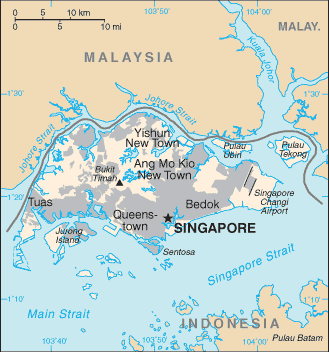 Singapore is a sovereign city state located on an island at the southern tip of the Malay peninsular. Its location gives it major importance for maritime trading routes between East and West. Singapore was founded by Sir Stamford Raffles in 1819, as one of the main ports for the British East India Company. At the time, there was a dispute about the succession to the Sultanate of Johor. Raffles helped the exiled older brother of the incumbent to return and be recognized as the rightful Sultan. Raffles and the new Sultan concluded a treaty which granted Britain the right to establish a trading post on the island.
Singapore is a sovereign city state located on an island at the southern tip of the Malay peninsular. Its location gives it major importance for maritime trading routes between East and West. Singapore was founded by Sir Stamford Raffles in 1819, as one of the main ports for the British East India Company. At the time, there was a dispute about the succession to the Sultanate of Johor. Raffles helped the exiled older brother of the incumbent to return and be recognized as the rightful Sultan. Raffles and the new Sultan concluded a treaty which granted Britain the right to establish a trading post on the island.
In 1858 Singapore was ceded to the British government as a Crown Colony, and remained as such until WW II.
During WW II Singapore concentrated on maritime defenses and the control of the seas - there were no defenses against attack by land, and the main British fleet was occupied in the Mediterranean. The Japanese used their bases in Siam to launch an attack on Malaya in 1941, and then across to Singapore in 1942.
After WW II there was growing resentment and anti-colonial feeling, due to Britain's inability to defend Singapore and its citizens. The movement towards independence grew, and was agreed to by Britain.
In 1959 the Peoples Action Party (PAP) won the elections by a massive majority, and Singapore became an internally self-governing state within the Commonwealth. It had a Prime Minister and a Governor/Head of State or Yang di-Pertuan Negara. The PAP has won every election since then, and is still the majority party in the government.
In 1963 Singapore attained full independence from Britain by joining the federation of Malaysia.
However, there were some great ideological differences between Singapore and the Malaysian states, and the situation continued to deteriorate until 1965, when the Malaysian Prime Minister advised the Malaysian Parliament that the only viable solution was to expel Singapore from the Federation. The Parliament voted unanimously and amended the constitution, to expel Singapore (the vote was 126 to 0, with the Singaporean delegates absent). Singapore became a sovereign country by itself.
Singapore is multi-ethnic, multi-lingual with four official languages (English, Malay, Mandarin Chinese, and Tamil). According to the PEW report, Singapore is the most religiously diverse country in the world. It has a unicameral parliamentary government with a majority political party which has won every election since Singapore became self-governing in 1959.
One peculiarity of the system for the election of the President was introduced by a constitutional amendment in 2016 : there are three recognized 'ethnic communities' in Singapore (Chinese, Malay, and Indian and other minorities). A 'reserved presidential election' must be held if no-one from a particular community has been President for any of the last five presidential terms : only members of that community will be eligible to become President. This situation occurred in 2017, when the election was reserved for the Malay community, and Halimah Yacob became the first female President of Singapore.
Brunei
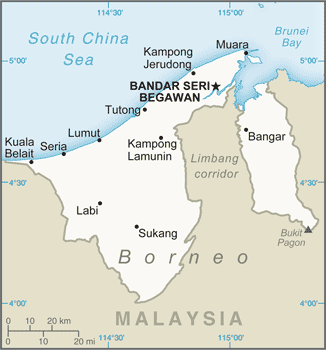 Modern Brunei consists of two pieces of land on the north-west coast of the island of Borneo. In antiquity, Brunei controlled most of the coastland of the island of Borneo, and parts of the Philippines. During the fifteenth century Indian and Arab traders brought Islam to the region, and the King of Brunei became a Muslim and made his kingdom follow suit. Because of its location it became one of the main hubs for maritime trade between the East and the West. Regular trade with Portuguese merchants was established by 1530. Strife over the royal succession, coastal piracy, and encroachment by the Spanish in the Philippines, the Dutch in Southern Borneo, and the British in North Borneo pushed Brunei into decline. In 1888 the Sultan of Brunei appealed to the British to curb the encroachment, and signed a treaty which turned Brunei into a British protectorate.
Modern Brunei consists of two pieces of land on the north-west coast of the island of Borneo. In antiquity, Brunei controlled most of the coastland of the island of Borneo, and parts of the Philippines. During the fifteenth century Indian and Arab traders brought Islam to the region, and the King of Brunei became a Muslim and made his kingdom follow suit. Because of its location it became one of the main hubs for maritime trade between the East and the West. Regular trade with Portuguese merchants was established by 1530. Strife over the royal succession, coastal piracy, and encroachment by the Spanish in the Philippines, the Dutch in Southern Borneo, and the British in North Borneo pushed Brunei into decline. In 1888 the Sultan of Brunei appealed to the British to curb the encroachment, and signed a treaty which turned Brunei into a British protectorate.
Brunei became an independent state in 1984.
Brunei has been ruled by members of the same royal family for the past 600 years. In 2017 Sultan Hassanal Bolkiah celebrated the 50th anniversary of his accession to the throne.
Borneo
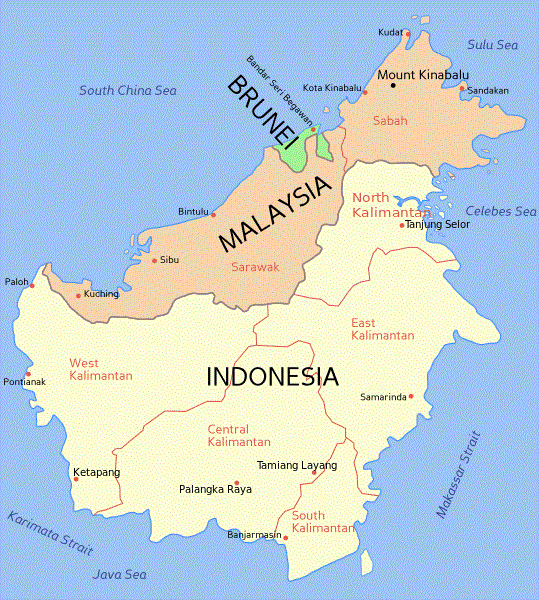 the island of Borneo is an anomalous case - part of it belongs to Indonesia, part to Malaysia, and two small regions comprise what is left of the sultanate of Brunei.
the island of Borneo is an anomalous case - part of it belongs to Indonesia, part to Malaysia, and two small regions comprise what is left of the sultanate of Brunei.
In 1946, with the fall of the Japanese occupation, and the conclusion of the British Military Administration, Britain established the Crown Colony of North Borneo. When the Federation of Malaysia was formed in 1963, the Crown Colony of North Borneo joined the Federation of Malaysia, and was renamed the state of Sabah - it is now part of East Malaysia.
Indonesia
 Indonesia comprises a group of islands, and parts of islands, between the Indian Ocean and the Pacific - Sumatra, Java, Celebes (Sulawesi), the western half of New Guinea, the western half of Timor, a large part of Borneo, and many smaller islands. The Dutch east India Company colonized the region in the early seventeenth century, when it was called the Dutch East Indies. Government of the colonies was taken over by the Dutch government in 1800. The Dutch remained in control until the Japanese invasion of 1942 during WW II.
Indonesia comprises a group of islands, and parts of islands, between the Indian Ocean and the Pacific - Sumatra, Java, Celebes (Sulawesi), the western half of New Guinea, the western half of Timor, a large part of Borneo, and many smaller islands. The Dutch east India Company colonized the region in the early seventeenth century, when it was called the Dutch East Indies. Government of the colonies was taken over by the Dutch government in 1800. The Dutch remained in control until the Japanese invasion of 1942 during WW II.
Indonesia declared its independence as soon WW II ended, but the Dutch were not willing to give up their colony. Several years of fighting ensued until the UN intervened. The Netherlands finally agreed to relinquish their control in 1949. There followed a long period of civil unrest, martial law, and an attempted military coup, until democratic elections were held in 1999. According to the CIA World Fact Book, Indonesia is now the world's largest Muslim-majority nation.
Timor
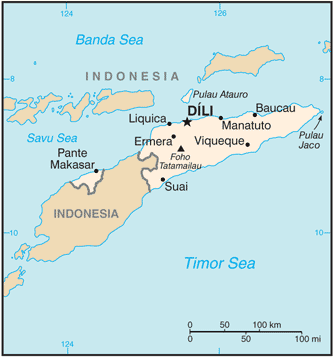 According to the World Fact Book of the CIA :
According to the World Fact Book of the CIA :
"The Portuguese began to trade with the island of Timor in the early 16th century and colonized it in mid-century.
Skirmishing with the Dutch in the region eventually resulted in an 1859 treaty in which Portugal ceded the western portion of the island.
Imperial Japan occupied Portuguese Timor from 1942 to 1945, but Portugal resumed colonial authority after the Japanese defeat in World War II.
East Timor declared itself independent from Portugal on 28 November 1975 and was invaded and occupied by Indonesian forces nine days later. It was incorporated into Indonesia in July 1976 as the province of Timor Timur (East Timor).
An unsuccessful campaign of pacification followed over the next two decades, during which an estimated 100,000 to 250,000 people died. In an August 1999 UN-supervised popular referendum, an overwhelming majority of the people of Timor-Leste voted for independence from Indonesia. However, in the next three weeks, anti-independence Timorese militias - organized and supported by the Indonesian military - commenced a large-scale, scorched-earth campaign of retribution. The militias killed approximately 1,400 Timorese and forced 300,000 people into western Timor as refugees. Most of the country's infrastructure, including homes, irrigation systems, water supply systems, and schools, and nearly all of the country's electrical grid were destroyed.
On 20 September 1999, Australian-led peacekeeping troops deployed to the country and brought the violence to an end.
On 20 May 2002, Timor-Leste was internationally recognized as an independent state."
Papua New Guinea
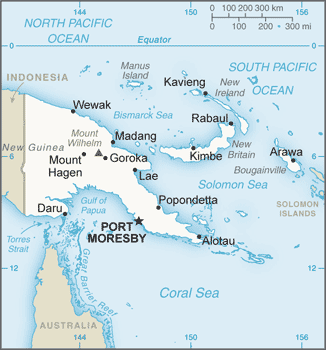 According to the World Fact Book of the CIA :
According to the World Fact Book of the CIA :
"The eastern half of the island of New Guinea . . . was divided between Germany (north) and the UK (south) in 1885. The latter area was transferred to Australia in 1902, which occupied the northern portion during World War I and continued to administer the combined areas until independence in 1975.
A nine-year secessionist revolt on the island of Bougainville ended in 1997 after claiming some 20,000 lives. Since 2001, Bougainville has experienced autonomy. Under the terms of a peace accord, 2015 is the year that a five-year window opens for a referendum on the question of independence."
The Philippines
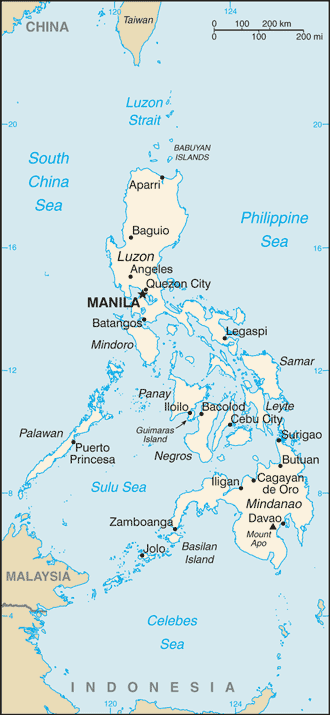 According to the World Fact Book of the CIA :
According to the World Fact Book of the CIA :
"The Philippine Islands became a Spanish colony during the 16th century; they were ceded to the US in 1898 following the Spanish-American War.
In 1935 the Philippines became a self-governing commonwealth. Manuel Quezon was elected president and was tasked with preparing the country for independence after a 10-year transition. In 1942 the islands fell under Japanese occupation during World War II, and US forces and Filipinos fought together during 1944-45 to regain control. On 4 July 1946 the Republic of the Philippines attained its independence.
A 20-year rule by Ferdinand Marcos ended in 1986, when a "people power" movement in Manila forced him into exile and installed Corazon Aquino as president."
Copyright © 1999 Shirley J. Rollinson, all Rights Reserved
